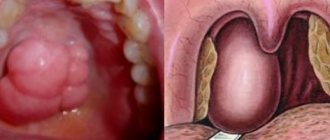Pus in the throat can occur against the background of the development of various inflammatory processes. However, its appearance also differs.
Sometimes the tonsils and mucous membranes are covered with a copious coating of white or gray color, in other cases single lesions of all sizes and shapes are formed, etc.
But almost always patients are plagued by pain of varying degrees of intensity.
It is imperative to deal with the problem, since pus is never considered a harmless sign of a disease.
It can have a toxic effect on the body, and when it penetrates blood vessels, it can spread throughout the body and affect vital organs, thereby causing death.
Causes of pus formation in the throat
The main reason where pus comes from in the oral cavity is considered to be bacterial infections, which can have different origins. It is most often observed in diseases:
1
Sore throat is an acute inflammation in the throat that affects the tonsils. Usually it develops quickly and is quite difficult. Depending on the area of the lesion, a distinction is made between the lacunae form and the follicular one. In the first case, plugs are formed in special recesses of the tonsils, which can be white or yellow.
In the second, small foci of suppuration form on the surface of the tonsils, capable of opening on their own. Liquid contents leak out of them, resulting in a pus-like taste and unpleasant odor in the mouth.
2
Chronic tonsillitis. The disease is characterized by the constant presence of infection in the tissues of the tonsils. In the acute stage, plugs are visible inside the tonsils, while the general condition of the patients worsens slightly.
What does pus in the throat look like: photo
3
Diphtheria is a dangerous infectious disease, accompanied by the formation of a characteristic dense gray or yellow coating on the tonsils, which looks very similar to purulent deposits.
The film is firmly connected to the surface of the mucous membrane, so any attempts to remove it by mechanical means are accompanied by bleeding. In severe cases, plaque may spread to other surfaces of the mouth.
4
Sinusitis is an acute or chronic inflammatory process in which pus collects in the paranasal sinuses (maximum, frontal, etc.).
With this pathology, patients constantly suffer from headaches, deterioration of general condition and nasal congestion, which usually goes away in the morning and reaches its maximum severity in the evening. There is often a taste of pus in the mouth.
5
Peritonsillar abscess is an inflammation of the tissue surrounding the tonsil, in which a cavity with pus is formed, prone to constant growth. This is one of the possible complications of a sore throat or injury. In the absence of timely medical intervention, an abscess can cause respiratory failure and sepsis.
Pus in the throat photo
Causes of white ulcers in the throat
Infection can occur as a result of the invasion of viruses, bacteria (streptococcus, staphylococcus, enterococcus, Pseudomonas aeruginosa), and fungi.
We advise you to read: Skin swelling due to allergies
The body gives an immune response to the attack of microbes, sending special cells - macrophages - to fight the “strangers”.
An abscess is the result of such a protective reaction in the form of an accumulation of macrophages, leukocytes and other elements.
No fever or pain
Abscesses in the throat without pain and fever - this clinical picture does not occur too often:
- with an atypical form of tonsillitis (acute tonsillitis) – the cause of its development is a significant weakening of the immune system, including due to improper use of antibiotics;
- in chronic tonsillitis, frequent relapses of damage to the palatine tonsils occur. The patient almost always has white or yellow plugs in the lacunae of the tonsils. The disease is characterized by an unpleasant odor from the mouth, a purulent taste, and a feeling of the presence of a foreign object in the throat. Although the inflammatory process is sluggish, it is dangerous due to complications in the form of diseases of the joints, heart, and kidneys. If chronic tonsillitis does not improve with medication, tonsil removal may be recommended;
- with pharyngomycosis - infection with fungal microflora, most often from the genus Candida. Both adults and children can suffer from candidiasis or thrush, even at a very early age. The disease is provoked by a decrease in immunity due to prolonged or uncontrolled use of antibiotics, non-compliance with hygiene rules;
- with stomatitis - a common inflammation of the entire oral cavity, right down to the back wall of the pharynx. The patient has a white coating on the mucous membrane and ulcerative formations. Stomatitis occurs when oral hygiene is impaired, as well as as a result of vitamin deficiency and diseases of the gastrointestinal tract. We wrote in detail about aphthous stomatitis here.
If available
Among the most common causes of ulcers in the throat, it is worth noting the following diseases:
- Acute tonsillitis or tonsillitis (lacunar, follicular) is an infectious disease in which the palatine tonsils become inflamed. The course of the disease is characterized by high temperature, fever, enlarged tonsils and cervical lymph nodes. The patient has a sore throat, especially when swallowing. The general condition of the patient worsens - lethargy and weakness are felt. The causative agents of sore throat can be bacteria and viruses.
- Herpetic (herpetic) sore throat - it is characterized by rapidly maturing ulcers filled with clear serous fluid. When the formations are opened, areas of bright red erosion form on the mucosa. The disease is caused by the Coxsackie virus (from the enterovirus family). We talked about the symptoms and treatment of herpetic sore throat in children in this article.
- Peritonsillar abscess is a complication of tonsillitis, which is manifested by a strong enlargement of the tonsils with the formation of ulcers on them. The development of pathology is accompanied by severe intoxication of the body, a sharp increase in temperature, pain and a feeling of a lump in the throat. The disease occurs due to the entry of pathogenic microorganisms into the tissues that surround the palatine tonsils.
- Pharyngitis is an infectious inflammation of the pharyngeal mucosa and lymphoid tissue. Most often, the causative agents of the disease are viruses and bacteria. White ulcers appear on the back of the throat. In addition to pain, the patient feels dryness and scratching, he is bothered by a dry cough, body temperature rises, and breathing is difficult.
- Diphtheria is a dangerous infectious disease in which an acute inflammatory process develops in the oropharynx. The pathology is caused by Loeffler's bacillus (diphtheria bacillus). The disease is characterized by the appearance of plaque in the throat, swelling of the tonsils and palate, pain during swallowing, and fever. Diphtheria is dangerous due to the risk of death as a result of poisoning of the body with toxins produced by the infectious agent.
- Scarlet fever is an acute infectious disease that occurs as a result of pyogenic streptococcus entering the body. The prerequisite for the disease is weakened immunity. Children under 10 years of age are most often affected. It manifests itself as redness of the mucous membrane of the throat, a gray-white coating on the tongue, enlarged tonsils and cervical lymph nodes, a rash throughout the body, high fever, and a general deterioration in health.
Symptoms
Most diseases in which pus on the surface of the mucous membranes of the oral cavity is visible to the naked eye occur with fever. Also typical for everyone:
- the presence of pain, soreness or soreness in the throat when swallowing or at rest;
- increased size of lymph nodes;
- the appearance of bad breath.
Patients often complain of coughing up and coughing up pus, or at least a purulent taste in the mouth.
If a patient has sinusitis, he will additionally experience:
- headache;
- yellow or green nasal discharge;
- discomfort in the area of the affected paranasal sinuses;
- nasal congestion.
Without fever, usually only infections occur that the immune system has stopped fighting, that is, chronic ones.
In this case, the disease will regularly recur after hypothermia, severe stress, etc.
Pus in the throat of a child despite normal health is often a consequence of the presence of a foreign body in the nose. In any case, the baby must be shown to a doctor.
Only a doctor will be able to correctly determine the reasons why white pus accumulates on the walls of the throat and tell you what to do in this situation. Source: nasmorkam.net
Purulent tonsils without fever: diagnoses, treatment
Sore throat is not always accompanied by fever and severe malaise. For this reason, many do not complete the treatment of this terrible disease. This is where the development of chronic tonsillitis begins. This is the most common disease in which an abscess on the tonsil appears without fever and does not hurt, but poses a serious threat to the body.
Photo: chronic tonsillitis
With chronic tonsillitis, the tonsils become inflamed at the slightest hypothermia, exposure to infection, or are constantly in an inflamed state. Toxins, which are waste products of pathogens, enter the bloodstream and systematically poison the entire body, causing allergic reactions. This leads to a decrease in immunity, against the background of which a person becomes vulnerable to any infections. It turns out to be a vicious circle.
If there are ulcers on the tonsils and there is no temperature, treatment without medical supervision is also unacceptable. Chronic diseases are not treated with antibiotics so as not to further disturb the bacterial balance. Instead, local antiseptic drugs are prescribed: Grammidin, Miramistin, Lugol, Dioxidin, Octinecept. As well as therapeutic rinses and medicinal inhalations with a nebulizer.
READ ALSO: How to treat a boil without getting blood poisoning - Lifehacker
Washing the tonsils with the “tonsillor” apparatus
At the same time, local immunity is activated with Immudon tablets or natural remedies: ginseng, propolis, pantocrine.
In addition to such conservative treatment methods, specialists in clinics also use modern ones:
- washing of festering lacunae with the “tonsillor” apparatus;
- laser therapy;
- ultrasonic irrigation;
- ultraviolet irradiation;
- vibroacoustic impact.
If, despite all efforts at systemic treatment, chronic tonsillitis worsens more than four times a year, the affected tonsils apparently cannot be cured and will have to be removed: instead of a barrier to the infection, they themselves have become its chronic focus.
In addition to tonsillitis, pus without fever can also cause other diseases . That is why before starting treatment, the doctor must establish the correct diagnosis. Sometimes people think, when they see white pustules on the tonsils, that it is a sore throat and swallow antibiotics, but the analysis shows that it is candidiasis, which can only be gotten rid of with antifungal drugs.
How do doctors treat a throat: when should you contact it?
When there is a sore throat and pus in the throat, this is the reason for mandatory seeking qualified medical help, since any purulent process poses a serious threat not only to the health, but also to the life of the patient.
Under no circumstances should you try to mechanically wipe away pus on the tonsils or squeeze out plugs on your own, as this is fraught with complications.
How is the diagnosis done?
For an experienced otolaryngologist, determining the name of the disease that provoked the formation of purulent plaque or plugs is not difficult. To do this, a simple visual inspection is usually enough for him.
To confirm the diagnosis, especially in complex cases, the following is carried out:
- general blood analysis;
- bacteriological examination of a throat smear.
Bacterial culture provides especially important information. Based on its results, you can understand which microorganism caused the inflammatory process and its sensitivity to all kinds of antibiotics.
How to treat pus in the throat?
If you notice that the tonsils are purulent, or there are white swellings on the back wall of the nasopharynx, behind the uvula, or in any other area in an adult or child, you should first consult a doctor.
Only a specialist will be able to correctly understand what caused the condition and select the optimal therapy.
In most cases, treatment is carried out at home. However, in particularly severe advanced situations, hospitalization may be required, but this is extremely rare.
Other causes of stones in the tonsils
In most cases, the cause of the formation of whitish plugs on the tonsils that have an unpleasant odor is chronic tonsillitis. But she is not the only one possible. White lumps on the tonsils can be found with the following diseases:
- Chronic sinusitis. With this disease, thick whitish or yellow mucus is produced, which accumulates in the larynx area. Clots of mucus become the culprits of the unpleasant odor from the mouth and lead to a strong cough with sputum, which may contain miniature whitish balls.
- Peritonsillar abscess that occurs against the background of advanced acute or chronic tonsillitis. The disease is characterized by the accumulation of pus in one of the tonsils. This pathological condition is accompanied by a sore throat, high body temperature and painful sensations in the neck.
- Oral candidiasis is another reason for the appearance of white balls in the throat. The disease, caused by the activation of fungi of the Candida albicans group, leads to the appearance of whitish deposits in any part of the oral cavity: on the tongue, inside the cheeks, gums, palate, tonsils.
The appearance of painless tumors in the tonsil area may indicate salivary gland cancer. Therefore, if any tumors or formations appear in this part of the oral cavity, you should consult a doctor as soon as possible.
Pus in the throat without fever: how to treat?
The absence of fever is a sign that the immune system is not fighting the infection. Therefore, when there is pus but no temperature, this usually indicates chronic tonsillitis, sometimes it even occurs without a sore throat.
However, this is also a reason to consult an otolaryngologist, since chronic tonsillitis can sooner or later lead to damage to the joints, heart and kidneys. If it is detected, patients are prescribed:
- sufficiently long-term antibiotic therapy, and the specific drug is selected only on the basis of bacterial culture results;
- antiseptic solutions for gargling;
- drugs of the NSAID group;
- washing lacunae;
- physiotherapy: UV therapy, laser therapy, vibroacoustic effects, etc.
If there is no effect from the measures taken and severe damage to the tonsils, surgical intervention is recommended.
How to get rid of ulcers on the tonsils for pregnant women and children
These are special categories of patients for whom many medications are contraindicated, while the immune system is not working at full strength. For pregnant women, sore throat is dangerous at any stage. In the first trimester, the disease can cause severe toxicosis, the threat of miscarriage, or disrupt the development of the unborn child.
At any time, typical complications of the disease may occur, as well as a weakening of labor due to a general decrease in the body’s defenses. Ideally, chronic tonsillitis is treated at the stage of pregnancy planning.
READ ALSO: Enterovirus in children: symptoms and treatment
In a situation where abscesses on the tonsils appear in a pregnant woman, the therapist and obstetrician-gynecologist decide how to treat the disease. First of all, topical medications, antiseptic and anti-inflammatory rinses will be prescribed.
If in a serious situation the doctor prescribes antibiotic treatment, you should not refuse: they will bring more benefit than harm.
Pustules in the throat in infants under one year of age are usually treated in a hospital setting: the risk of rapid development of edema and severe intoxication is too great. In children older than one year, it is somewhat easier to treat ulcers that appear on the tonsils: they have already developed their own immunity. But he is still too weak to get rid of the pus without antibiotic therapy.
Children under 3 years of age are very prone to allergies, therefore, without consulting a pediatrician, not only antibiotics, but also herbal remedies should not be used to treat them.
To reduce the temperature from 38 °C, both pregnant women and babies are prohibited from taking aspirin . Only paracetamol-based drugs are allowed. You cannot steam your feet, do steam inhalations, or perform any other warming procedures.
Treatment of suppuration in the throat with folk remedies
No home remedies can completely remove persistent pus in the tonsils. Therefore, they can only be used as a complement to the main therapy, and only with the permission of the doctor. [ads-pc-1][ads-mob-1] When tonsils in ulcers come to the rescue:
1
Slow absorption of honey. As you know, this popular beekeeping product has anti-inflammatory and antiseptic properties. It is recommended to dissolve it in a tablespoon three times a day, but only if there are no allergies.
2
Gargling with infusions and decoctions of medicinal herbs. The most commonly used products are those based on chamomile flowers, calendula and sage leaves. A tablespoon of the selected plant material is placed in a cup and poured with boiling water. After 20–60 minutes, you can start rinsing.
3
Aromatherapy. Inhaling the healing vapors of essential oils has a beneficial effect on the general condition and course of the inflammatory process. If you add a few drops of tea tree or eucalyptus oil to a saline solution and perform inhalation, you can speed up the elimination of ulcers.
4
Saline solution. This is the simplest remedy that is often used to cure the inflammatory process. For rinsing, regular saline solution or homemade solution is suitable. It is prepared by dissolving a teaspoon of sea salt in a glass of water.
Prevention
It is unlikely that anyone will be able to completely avoid infections. Nevertheless, to prevent purulent tonsils from becoming a constant companion of life, you should consult a doctor when the first signs of a bacterial infection appear and strictly follow the recommendations received.
When starting to take antibiotics, it is very important to complete the prescribed course, even despite the improvements that have occurred.
And to reduce the risk of inflammatory processes, you should lead a healthy lifestyle, give up bad habits, devote time to sports, etc.








